Excerpts from Jim Conrad's
Naturalist Newsletter
from the November 19, 2017 Newsletter issued from Rancho Regenesis in the woods ±4kms west of Ek Balam Ruins; elevation ~40m (~130 ft), N20.876°, W88.170°; north-central Yucatán, MÉXICO
TURMERIC HARVEST
About twenty handsome, broad-leafed CURCUMA LONGA plants in the garden were waist high and I wondered if they were ready for harvest. Curcuma longa, a member of the Ginger Family, the Zingiberaceae, is the plant producing rhizomes from which the pungent and yellow-dying spice called turmeric is made. Below, you can see some of my plants:
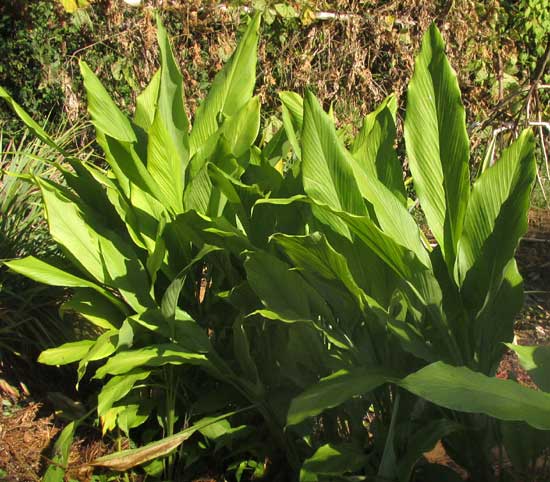
When I dug up the first plant, I could hardly believe my eyes, shown below:
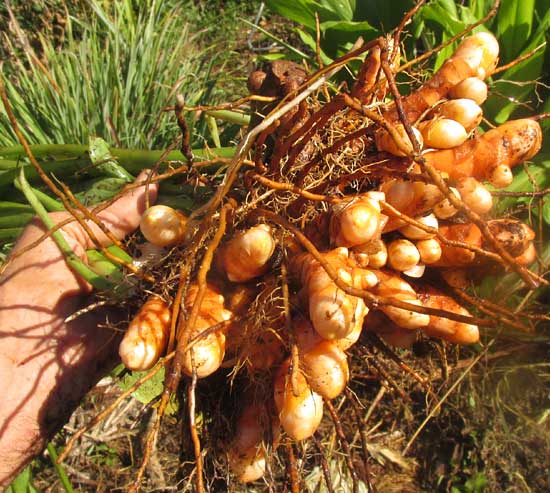
The orangish, toe-like things are rhizomes, and they're orangish because turmeric is the spice that gives curried dishes their golden color. Curry powder is a blend of turmeric, coriander, ginger and maybe other spices. The moment the rhizomes in the picture popped from the ground, the morning air was suffused with a strong spicy odor that instantly brought to mind my days in India when it was hard to find a meal that wasn't curried.
Some of the rhizomes were sprouting green stems. I broke them from the cluster and planted them as shown below:
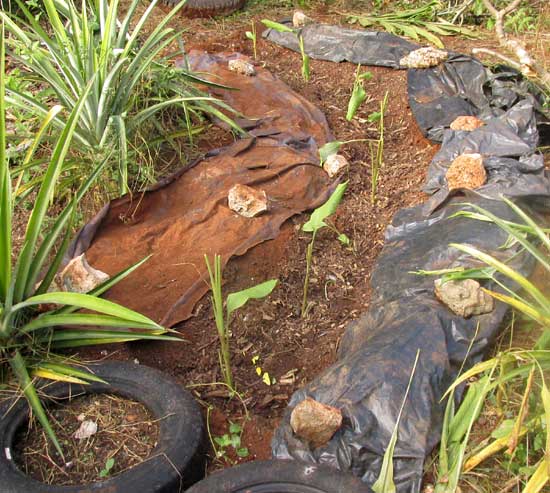
That plot was prepared with the long, intensely hot dry season coming up. The garden's soil has been compacted by cattle hooves for decades, and before that, depleted of organic matter by generations of Maya slash-and-burn, so first I pickaxed a trench in the brittle dirt, heaped up berms along the trench's sides, then pickaxed the trench deeper, wheelbarrowed in plenty of cow manure mixed with chopped, semi-rotted Guano-palm leaf (from rethatching a hut), and created loose, crumbly soil in which to plant the sprouting rhizomes. That's more or less how I prepared the rich, crumbly soil shown below:
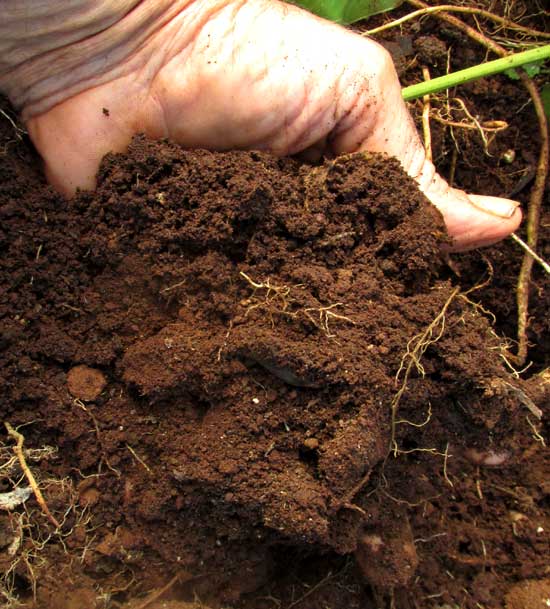
The plastic sheets covering the berms serve as mulch, to cut down on moisture loss during upcoming hot, dry months. The harvest shown in the pictures has come from plants that did most of their growing during the recent rainy season, so I'm uncertain how my luck will be with this new planting going into the dry season.
With this week's harvest, I've become a turmeric fan, wanting to know about it. I find that our Curcuma longa -- and that's a fine, old Linnaeus name -- is thought to have originated in southern Asia. None of my plants produced flowers, but when blossoms occur the resulting seeds are sterile, so plants reproduce only via their rhizomes. The species is thought to have arisen by selection and vegetative propagation of a hybrid between a wild turmeric plant and some closely related species.
In India, turmeric has been in use for at least 2500 years, and probably at first it served only as a dye, coming to be used as a condiment only later.
I read that the plant's rhizomes can be cured for use as a spice by boiling and steaming, or else by being boiled, dried, peeled and ground. However, I take a fresh, juicy piece of rhizome about as long as the last joint of my thumb, scrape it with a knife to produce something like orange, moist sawdust, and when that's added to my morning stew I can't imagine it being any better than it is. Below, you can see some of my rhizomes cleaned and undergoing enough drying to keep them from getting fungusy during storage:
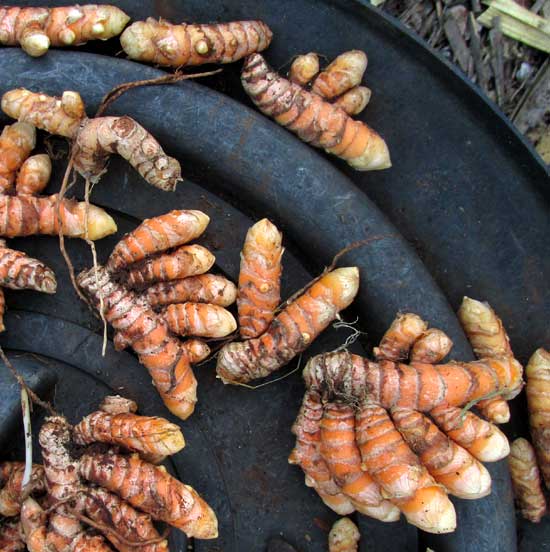
On the Internet I see a discussion about whether raw turmeric roots are toxic. I'm not eating them raw, though. In fact, I read that a little cooking, as I do with my morning stews, actually makes the spice's important compounds more available to the body.
The list of traditional medicinal uses of turmeric is so long that one starts to doubt them. However, Western science has confirmed that turmeric shows anti-bacterial, anti-fungal, antioxidant and anti-inflammatory effects, plus it shows potential for anti-ulcer, wound-healing, liver protective and anti-cancer uses. You might enjoy reviewing what Dr. Edward Group writes about it at the GlobalHealingCenter.Com website.
On that page, Dr. Group writes that "Turmeric contains many antioxidant compounds, of which curcumin is the most potent. In fact, studies have found that the antioxidant activities of this compound are ten times more effective than those of resveratrol, the much-hyped antioxidant in red wine." He also asserts that turmeric promotes cardiovascular health, helps maintain the liver, and resists harmful organisms. He calls it a "legitimate superfood."
Even without all the health claims, I'd be using the rhizomes in my morning stews if only because they color the stew so nicely, and add a good taste, along with a few coriander seeds and a chopped chili. Below, you can see my latest curried masterpiece:
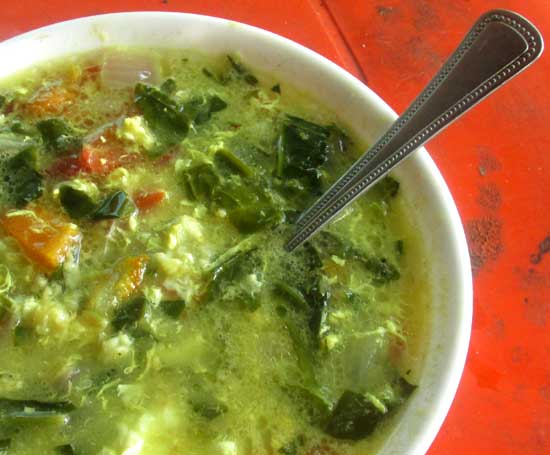
from the November 9, 2018 Newsletter issued from Rancho Regenesis in the woods ±4kms west of Ek Balam Ruins; elevation ~40m (~130 ft), N20.876°, W88.170°; north-central Yucatán, MÉXICO
TURMURIC FLOWERS
This week, for the first time in my two years of growing Turmeric, one and only one of my many plants turned up flowering, as shown below:
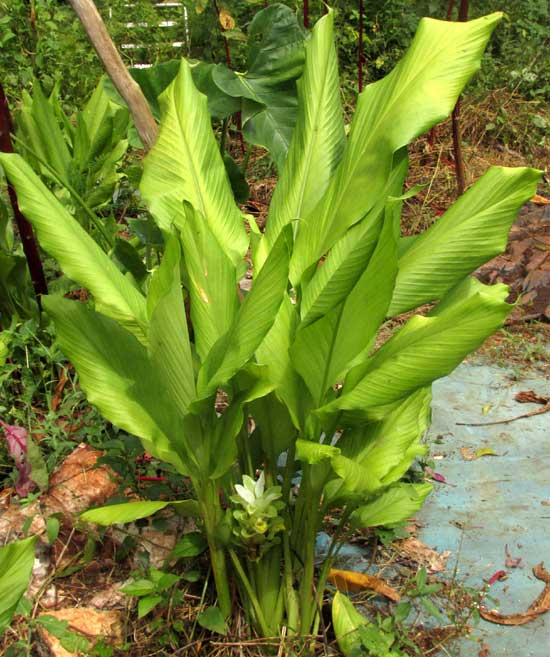
Toward the plant's base, note the white-topped, tufted thing. That's a flowering head, or inflorescence, and I don't know why its top leaves are white; maybe to make the inflorescence more visible to pollinators. However, the main leaves also are a bits chloritic, probably from sunburn, now that the dry season has begun and afternoon clouds have dispersed. A close-up of the inflorescence is shown below:
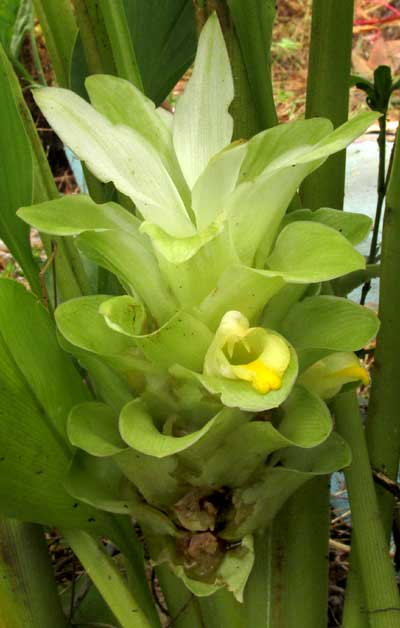
Most of the inflorescence is composed of reduced leaves called bracts -- a bract subtending each open flower. In the picture, a single corolla with a yellow lower lip snugly lies upon the curved bract below it. Below, that flower is shown closer up:
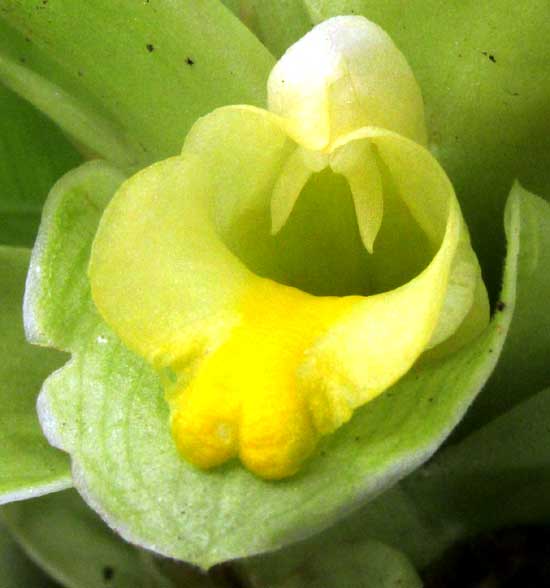
The corolla is "irregular," meaning that its lobes are not all alike. The top lobes curve into a kind of hood, those at the bottom expand into a broad landing pad for pollinators. The flowers are similar to those of snapdragons in that sense, but otherwise are very different. A big difference is this blossom's two white "teeth" dangling from the blossom's top. If you bend back the corolla's top and bottom, the "teeth" appear as seen below:
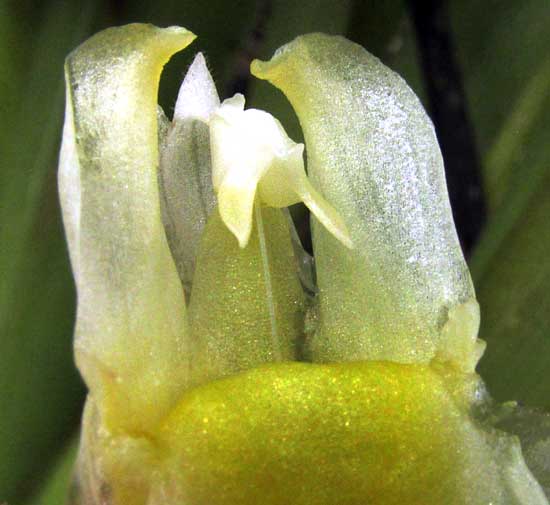
The "teeth" are what there is of the flower's single fertile stamen, such lone stamens constituting a feature of blossoms of the Ginger Family. However, within the family the stamens' pollen-producing anthers vary greatly. The anther form seen here is peculiar to Turmeric.
In the above picture, on both sides of the single stamen, arise two white, petal-like items, which are modified, sterile stamens called staminodes. Such petal-like staminodes are absent from flower of the closely related Ginger plant grown for its much-appreciated spicy rhizomes.
Otherwise, Turmeric flowers follow the usual pattern, as you can see from an entire one pulled from its inflorescence, shown below:
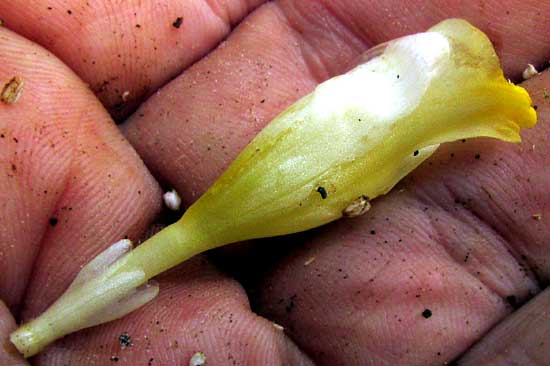
At the picture's lower left, the white calyx is perfectly average. The tubular, yellow corolla is of a usual kind, too. It's just with the lonely stamen with its weird anther, guarded by the two white staminodes that things get strange.
Why did this particular plant flower while none of the dozens of others did? Surely it's because, of all my Turmeric plants, only this one came up from a rhizome not purposefully planted and taken care of. Apparently when I was planting the others this plant's rhizome fell onto hard-packed soil I'd not broken up, and later did not water or fertilize. The biggest mystery is why this flowering plant also is considerably larger than those planted at the same time, and which I've taken care of. Genetically they're all the same, all clones from the same massive rhizome-stock.